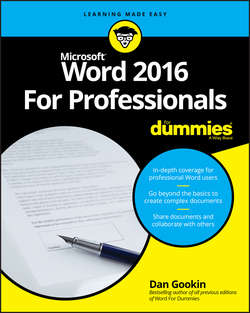Читать книгу Word 2016 For Professionals For Dummies - Dan Gookin - Страница 9
На сайте Литреса книга снята с продажи.
Part 1
Fancy Formatting and Froufrou
Chapter 1
Font Fun
Find and Replace Text Formatting
ОглавлениеOne item that relates to fonts but has nothing to do with aesthetics is Word’s capability to find and replace fonts and text formatting. Using this variation of the standard Find and Replace command is tricky, so pay attention!
To replace formatting, you must add and then subtract the text attributes. Before diving in, I have some bits of advice:
❯❯ If you use styles, it’s easier to modify a style than to globally search-and-replace a text format. That’s the best way to change an underlying typeface or text size.
❯❯ When you find and replace a text format, you must search for the first text format and then replace with the second format while removing the first. This sounds odd, which is why if you try this type of operation on your own, it might fail.
❯❯ Always remove the formatting attributes from the Find and Replace dialog box when you’re done. If you don’t, Word continues to search for text attributes, which may limit future searches.
Obey these steps to find and replace a text attribute, such as underline with italics:
1. Press Ctrl+Home to position the insertion pointer at the tippy-top of the document.
2. Press Ctrl+H to bring up the Find and Replace dialog box, with the Replace tab forward.
3. Click the More button to expand the Find and Replace dialog box.
4. Click the Find What text box, but leave it blank.
5. Click the Format button and choose Font from the menu.
The Font dialog box appears.
6. Select the format you want to find.
For example, click the Underline Style button and choose the single underline.
7. Click OK to close the Font dialog box and return to the Find and Replace dialog box.
8. Click the Replace text box and leave it blank.
9. Click the Format button and choose Font.
The Font dialog box appears again.
10. From the Font Style list, choose Italics.
11. From the Underline Style menu, choose None.
These two steps (10 and 11) carry out the important task of not only selecting the replacement text format but also removing the original text format. In this example, you’re choosing underline and replacing it with no underline and italics.
12. Click OK to close the Font dialog box.
13. The Search and Replace dialog box should look similar to Figure 1-15.
14. Click the Replace All button to search and replace the text attribute throughout the document.
A summary box appears, listing the number of replacements made.
15. Click OK to dismiss the summary.
Now come the important steps of removing the formatting attributes.
16. Click the Find What text box and click the No Formatting button.
17. Click the Replace With text box and click the No Formatting button.
These steps (16 and 17) remove formatting options from the next find-and-replace operation. That way, these options won’t mess up the next search or search-and-replace operation.
18. Click the Close button to dismiss the Find and Replace dialog box.
FIGURE 1-15: Replacing a text attribute.
If you were to replace italics with underline, you’d need to search for the Italic text style and replace it with the regular text style as well as the single-underline format. If you forget to remove the original text format, you end up with double formats instead of a search-and-replace.
You cannot use the steps in this section to peel away text effects. The Text Effects button isn’t available in the Font dialog box you summon in Steps 5 and 9.
BRING BACK THE OLD FIND DIALOG BOX
Starting with Word 2010, Microsoft set the standard Find command in the Navigation pane; gone is the old Find dialog box, which is now called the Advanced Find dialog box. You can bring back that dialog box by mapping it to the Ctrl+F keyboard shortcut.
Generally speaking, I don’t recommend that you re-assign Word’s default keyboard shortcuts. For the old Find dialog box, I’m willing to make an exception to that rule. If you’re okay with changing a default keyboard shortcut, follow these steps:
1. Choose Options to conjure forth the Word Options dialog box.
2. Choose the category Customize the Ribbon.
3. Click the Customize button next to Keyboard Shortcuts to bring up the Customize Keyboard dialog box.
4. From the Categories list, choose Home Tab.
5. From the Commands list, choose EditFind.
6. Click the mouse in the Press New Shortcut Key box.
7. Press Ctrl+F.
8. Click the Assign button.
9. Click the Close button to close the Customize Keyboard dialog box.
10. Click the Close button to close the Word Options dialog box.
The Ctrl+F keyboard shortcut now summons the Advanced Find dialog box, which I believe is better suited to a high-end Word user than the Search Document text box on the Navigation pane.
